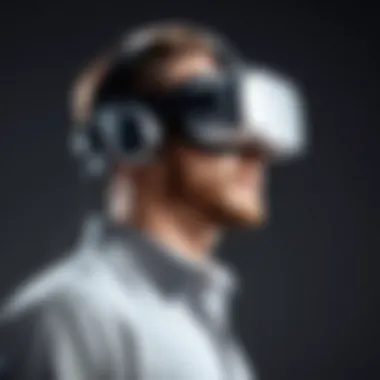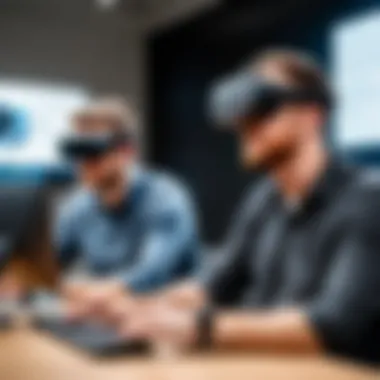Understanding Oculus Employees: Their Roles and Impact


Intro
The realm of virtual reality is rapidly evolving, with Oculus at the forefront of this transformation. Understanding the employees behind Oculus reveals much about the innovative processes and technologies that drive this industry forward. Each employee brings unique skills and perspectives, contributing to a collaborative environment that prioritizes groundbreaking development and user experience. This article will explore the various roles that Oculus employees assume, their invaluable contributions to virtual reality, and the impact they have not only within the company but also on the broader tech landscape.
Roles and Responsibilities of Oculus Employees
Oculus employs a range of professionals who specialize in different areas, all focused on the creation and refinement of virtual reality experiences. Here are some of the primary roles that shape the company:
- Software Engineers: These individuals develop the software that powers Oculus devices. Their expertise in programming languages and VR-specific coding is essential for creating immersive experiences.
- Product Designers: They focus on the user interface and overall design of the product. This role requires a strong understanding of user experience (UX) principles to ensure a smooth and engaging interaction with the technology.
- Quality Assurance Testers: Before any update or product is released, quality assurance testers rigorously evaluate the functionality, usability, and performance. Their work ensures that end-users have a positive experience.
- Marketing Specialists: They play a pivotal role in promoting Oculus products. Understanding consumer behavior and market trends helps these individuals create strategies that resonate with target audiences.
Contributions to Virtual Reality
Oculus employees play a vital role in the development of virtual reality technology. Their work extends beyond just creating products; they also contribute to shaping industry standards and practices. Here are some key contributions made by Oculus employees:
- Innovation: Through research and development, Oculus employees push the boundaries of what is possible in VR. Their willingness to explore uncharted territory leads to groundbreaking innovations.
- User Experience Design: Employees are focused on enhancing the user experience. From intuitive controls to realistic graphics, they ensure that each new release meets high expectations.
- Community Engagement: By interacting directly with users through forums and social media, employees gather valuable feedback that informs future designs and updates.
"The strength of the Oculus team lies in its diversity of thought and expertise, which fosters a culture of innovation and progress."
The Impact of Oculus Employees on the Tech Landscape
The influence of Oculus employees goes beyond the confines of the company. They contribute significantly to the wider technology ecosystem. Their work impacts how virtual reality is integrated into various sectors, from gaming to education and therapy. Here are a few notable impacts:
- Setting Industry Standards: By developing cutting-edge technology, Oculus employees help establish benchmarks that other companies aim to meet or exceed.
- Driving Adoption of Virtual Reality: As Oculus products become more sophisticated and user-friendly, they encourage wider adoption of VR across various industries.
- Inspiring Future Innovators: The achievements of Oculus employees serve as motivation for aspiring professionals in technology and gaming, fostering a new generation of innovators.
The End
Oculus employees are integral to the company's progression and success in the virtual reality market. Their diverse roles and collective contributions shape the user experience and set standards for the tech industry. Understanding their impact offers valuable insights into the future of virtual reality technology and its potential trajectory. As the field continues to innovate, the contributions of Oculus's team will likely remain at the forefront.
Foreword to Oculus
The exploration of Oculus is paramount in understanding not just the company itself but the broader implications of its work in the realm of virtual reality. The Oculus brand symbolizes innovation and technological evolution, driving not only advancements in gaming but reshaping how we interact with digital environments. Recognizing the dynamics at play within Oculus and its workforce is essential for anyone interested in the tech landscape, particularly enthusiasts of gaming and virtual reality.
This section lays the groundwork for a comprehensive examination of what makes Oculus a leader in its field. We will delve into the specific roles that employees play, how their contributions shape the company's trajectory, and the overall culture that fosters creativity and progression. By understanding these factors, readers can appreciate the intricate relationship between a company's workforce and its innovations.
Overview of Oculus
Oculus, a division of Meta Platforms, Inc., is widely recognized for its contributions to virtual reality technologies. Established in 2012, the company gained significant attention with its early Kickstarter campaign, promising a new level of immersion in gaming and media. This endeavor attracted not just funding but also a community of enthusiasts eager to embrace the future of digital interaction.
The flagship product, Oculus Rift, set a standard in the VR market by combining high-quality graphics with responsive tracking systems. Today, Oculus is known for various devices, including Oculus Quest and Oculus Quest 2, which have democratized access to virtual reality experiences.
The core mission of Oculus is to help people connect and share through advanced technology. This mission shapes the development process and guides the team's focus toward creating user-friendly and impactful virtual experiences. With the evolution of social VR platforms, Oculus stands at the intersection of technology and human connection, striving to expand the possibilities of virtual environments.
Company History
The origins of Oculus are quite fascinating, rooted in a vision that started with Palmer Luckey in his garage. Luckey created the first prototype, which caught the eye of many in the technology community, leading to a major breakthrough. In 2014, Oculus was acquired by Facebook for approximately $2 billion, marking a significant turning point for the company.
Since then, Oculus has expanded rapidly, producing a range of products that cater to different market segments. The company has focused on improving both hardware and software to create a seamless and enriching user experience. This historical context is crucial for understanding the current landscape of virtual reality, as it highlights the rapid advancements that have taken place in a relatively short time.
With a commitment to research and development, Oculus combines their engineering prowess with a deep understanding of user engagement. The history of Oculus is not just about the devices they've created, but also the community they have fostered and the experiences they continue to deliver to users around the globe.


The Workforce at Oculus
The workforce at Oculus is a central pillar of the company's success. A balanced team of individuals with different backgrounds and skills allows Oculus to thrive in the competitive virtual reality landscape. Here, we explore the critical elements that make up this workforce, the benefits of a diverse team, and the significant considerations impacting their operations.
Employee Demographics
Understanding the employee demographics aids in recognizing how Oculus leverages diversity to enhance innovation. The workforce includes individuals from various ethnicities, genders, and educational backgrounds. This range of perspectives contributes to a more robust creative process. For instance, having employees from different countries can lead to insights into diverse market needs.
Data indicates that a more diverse environment fosters improved problem-solving capabilities and innovation. A cross-sectional data survey within Oculus shows that teams which include members from varied backgrounds are able to produce ideas with broader appeal. It enhances the overall effectiveness of products like the Oculus Quest and Rift.
Interdisciplinary Teams
Interdisciplinary teams are integral at Oculus. Workers from fields such as engineering, design, marketing, and psychology collaborate. This blend of skills enables teams to approach challenges from multiple angles. For example, while engineers tackle technical issues, designers focus on usability, ensuring a seamless experience.
Collaboration happens regularly through brainstorming sessions and work sprints. Teams often bring representatives from various departments together to immerse in a project. This support structure provides solutions that consider the project from every perspective, yielding well-rounded results. The practice not only enhances output quality but also promotes a culture where knowledge sharing is encouraged and rewarded.
Key Roles within Oculus
Several key roles within Oculus greatly influence the company's products and operations. Each position has designated responsibilities that contribute holistically to Oculus's mission.
- Software Engineers: They are the backbone of product development. They work on programming and coding essential for the virtual reality software.
- UI/UX Designers: Their role ensures that interfaces are user-friendly and visually compelling. Empathy for users guides their design choices.
- Product Managers: These individuals bridge the gap between engineering and marketing, prioritizing features aligned with business strategy. They make sure that the product's vision is clear and attainable for all teams involved.
- Data Analysts: They analyze user behavior and feedback. Their insights drive decisions around future product updates, ensuring the final product caters to user needs.
"Collaboration and diversity drive innovation. The workforce at Oculus exemplifies this through their united efforts to push the boundaries of technology."
Understanding these roles and their significance enhances appreciation of how Oculus maintains its position at the forefront of the gaming and technology sectors.
Roles and Responsibilities
Understanding the roles and responsibilities of Oculus employees is pivotal to appreciate the company’s contribution to the virtual reality landscape. These positions not only determine how projects are executed, but also shape the company's culture and drive innovation. Each role is strategically designed to complement others, creating an integrated workforce that enhances creativity and efficiency.
Engineering and Development
At Oculus, engineering and development professionals bear significant responsibility for creating and refining core technologies. They focus on the hardware and software that power virtual reality experiences. Their tasks range from coding innovative algorithms to designing hardware components like the Oculus Quest headset, which provides users with immersive experiences. Engineers at Oculus must work collaboratively, often drawing on insights from other departments, to ensure the technology is user-friendly and state-of-the-art.
The role of software developers also encompasses optimizing performance issues. By resolving bugs and improving the aesthetic dynamics of applications, they enhance overall user experience. Without this continuous development and engineering support, Oculus would struggle to stay competitive in the rapidly evolving tech industry.
Design and User Experience
Design and user experience are crucial in creating an engaging environment for users. This group focuses on aesthetic and functional aspects of VR applications. Designers are tasked with understanding user interaction to tailor experiences that are not simply visually appealing but also intuitive.
The user experience designers engage in research and testing with real users. Their findings drive design decisions, ensuring they align with user expectations and enhance satisfaction. This feedback loop is essential for iteratively improving the functionality of Oculus products.
Good design is not just about looks; it’s about how users feel when they interact with the technology. This emphasis on user-centric design distinguishes Oculus in the market.
Marketing and Community Engagement
Marketing and community engagement teams play an essential role in bridging the gap between Oculus and its audience. Their efforts encompass everything from promoting new products to engaging with users through social platforms and events. This team works to communicate the unique selling points of Oculus technology, facilitating users' understanding of how it enriches gaming and social experiences.
Beyond conventional marketing, community involvement is key. By fostering a loyal user base, they gather valuable insights and feedback that can guide development decisions. Engaging with communities on sites like Reddit allows Oculus to keep a pulse on user sentiments, preferences, and trends in gaming. This engagement helps shape future updates and product launches, enhancing the relationship between users and the brand.


Contributions to Virtual Reality
The contributions of Oculus employees to the realm of virtual reality (VR) cannot be underestimated. They have played a crucial role in shaping the products and experiences that define this emerging technology. This section will cover two primary areas: innovative product development and enhancing user experience. By understanding these contributions, we can appreciate how Oculus has established itself as a leader in this field.
Innovative Product Development
Oculus employees have been at the forefront of innovative product development. Their collective expertise spans various domains such as hardware engineering, software programming, and design. This interdisciplinary collaboration helps to push boundaries in what VR can offer.
Key aspects of their contributions include the following:
- Research and Development: Oculus invests heavily in R&D, allowing employees to explore new concepts and technologies. They focus on areas such as graphics rendering, motion tracking, and haptic feedback. Each advancement contributes to making VR experiences more immersive.
- Rapid Prototyping: The process of swiftly creating prototypes enables faster testing and feedback loops. Employees can iterate on concepts, refining them based on user feedback and technological advancements. This agility leads to quicker product launches.
- Integration with Existing Technologies: Oculus products often incorporate advancements from allied fields like gaming, mobile technology, and computing. Employees work to ensure compatibility and performance across platforms, enriching the user experience.
Oculus has released significant products, such as the Oculus Rift, Quest, and Quest 2. Each represents a step forward in technology, driven by dedicated employee contributions.
"The innovation in VR comes from interdisciplinary teams working together on complex challenges."
Enhancing User Experience
Enhancing user experience is another critical area where Oculus employees excel. Their role in understanding user needs and behaviors informs every aspect of product design.
The following points exemplify their contributions:
- User Research: Employees conduct comprehensive user research to gain insights into how people interact with VR. Understanding user preferences helps refine the interface and overall experience.
- Design Philosophy: The design teams focus on creating intuitive and accessible interfaces. This includes simplifying the setup process and improving navigation within VR environments. A well-designed user interface directly affects user satisfaction and retention.
- Continuous Improvement: Oculus employees prioritize continuous improvement. They gather user feedback post-release to identify areas needing enhancement. Regular updates to software and features ensure users always have a refined experience.
By investing significant time and resources into user experience, Oculus employees ensure that their products not only meet but exceed user expectations. This dedication is central to Oculus's reputation in the tech industry.
Company Culture and Values
Understanding the company culture and values of Oculus is essential to comprehend how the workforce operates and flourishes. These elements shape the work environment, influence employee satisfaction, and ultimately lead to the kind of innovation that Oculus is known for in the tech industry. A positive and adaptive culture encourages employees to fully engage in their work, making them more productive and creative. It fosters collaboration and establishes a sense of belonging among the employees.
Commitment to Innovation
A core aspect of Oculus' culture is its commitment to innovation. This commitment goes beyond simply developing new products; it involves a mindset that prioritizes creative thinking and problem-solving. Employees are encouraged to take risks, experiment with new ideas, and learn from failures. This culture of innovation is apparent in research and development initiatives which continually push the boundaries of virtual reality technology. Oculus employees often work on projects that aim to improve user experience significantly or create new avenues for gaming and training through virtual environments. This proactive approach makes the company a leader in the industry, setting trends rather than just following them.
Diversity and Inclusion
Diversity and inclusion are pivotal values within Oculus. The company acknowledges that a diverse workforce leads to richer ideas and perspectives, fostering creativity and innovation. Employees come from various backgrounds, cultures, and experiences, which enhances teamwork and collaboration. To support this commitment, Oculus implements hiring practices aimed at increasing representation across all levels of the organization. Moreover, ongoing training programs focus on creating an inclusive environment where all voices are heard and valued. This not only improves employee satisfaction but also helps the company access a broader market by understanding diverse customer needs and leveraging varied insights.
Employee Development Programs
Oculus invests significantly in employee development programs, recognizing that the growth of its workforce is synonymous with the company’s success. These programs include mentorship initiatives and continuous learning opportunities, ensuring employees can advance their skills in a rapidly changing tech landscape. Training sessions often incorporate topics such as the latest VR technologies, software development practices, and user-centered design principles. Through workshops, seminars, and peer learning, Oculus creates a culture where employees feel empowered to invest in their professional development. It positions them as prepared leaders of tomorrow, equipped to contribute effectively to the company's mission and vision.
The culture at Oculus emphasizes mutual respect, collaboration, and a relentless pursuit of excellence. It is more than just a workplace; it is a community of innovators.
In summary, the focus on innovation, diversity and inclusion, and comprehensive development programs illustrates how Oculus cultivates a unique and supportive culture. Understanding these values provides insights into the dynamics of the workforce and the company’s ability to thrive in the tech landscape.
Impact on the Tech Industry
The impact of Oculus employees on the tech industry is profound and multifaceted. As part of a leading company in virtual reality, their roles span from engineering to user experience design. This diverse workforce is crucial in pushing the boundaries of what virtual reality (VR) can achieve. Oculus employees are not just contributors; they are central to shaping the future of technology in a landscape that is continuously evolving.


The tech industry benefits from Oculus's innovative approaches. These contributions often lead to broader implications beyond just VR. The standards set by Oculus in hardware and software development have influenced competitors and newcomers alike. This creates an environment where innovation is essential. The ripple effects of Oculus's work can be observed in various sectors, including gaming, education, and healthcare. By embracing and integrating VR into these fields, Oculus employees help establish new norms for user engagement and interaction.
Setting Industry Standards
Oculus's influence extends significantly into setting industry standards. The company has long been praised for its relentless pursuit of quality and technical excellence. One notable aspect is the Oculus Quest series, which provided a standalone VR experience that did not heavily rely on external hardware. This innovation has encouraged other developers to reconsider their strategies regarding VR hardware and accessibility.
Through rigorous quality control, Oculus ensures that its products not only meet but often redefine user expectations. The performance metrics established by Oculus are benchmarks that others strive to achieve. Oculus employees play a pivotal role in this process, as their expertise in product design and programming underpins the success of these technologies. They engage in constant iteration and enhancement, which sets a high bar in the industry.
Collaborations and Partnerships
Collaborations and partnerships are another area where Oculus employees have a significant impact. By working with various companies and developers, Oculus amplifies innovation through shared knowledge. For example, partnerships with software developers have led to the creation of immersive applications that enhance the VR experience. This collaboration encourages cross-pollination of ideas, accelerating advancements not only within Oculus but across the VR industry.
Moreover, partnerships with research institutions facilitate exploration into new VR applications. This has significant implications for sectors like healthcare, where VR is used for training and treating patients. Oculus employees thus become ambassadors of technology in diverse fields, demonstrating how VR can be leveraged effectively.
The combined expertise of Oculus employees in engineering, design, and strategic partnerships stands as a testament to the transformative power of virtual reality in the tech industry.
The dedication of Oculus employees to both innovation and collaboration underscores their vital role in establishing the company as a leader in tech. Their influence resolves in advancements that continually impact user experiences and industry practices.
Future Trends in VR
Virtual Reality (VR) continues to evolve at a rapid pace, shaping new paradigms in technology and user experience. In this section, we will explore anticipated developments and the pivotal role Oculus employees will play in driving these innovations. Understanding these trends is essential not only for industry professionals but also for enthusiasts eager to glean insights into the future of VR technology.
Anticipated Developments
Several trends are emerging that could redefine the landscape of virtual reality. These developments include:
- Improvements in Hardware: As technology advances, we can expect more powerful and lightweight VR headsets. Companies like Oculus are working on higher resolution displays, improved field of view, and better refresh rates. These improvements will enhance immersion and reduce motion sickness.
- Integration with AI: Artificial intelligence is poised to revolutionize VR. By leveraging AI, Oculus can offer personalized experiences that adapt to user preferences and behavior. AI can also simulate realistic environments and NPC (non-player character) interactions, creating a more engaging experience.
- Expanded Applications Beyond Gaming: While gaming is a significant driver for VR, other sectors like education, healthcare, and remote work are increasingly adopting VR solutions. Oculus employees can contribute to developing applications that support these diverse use cases, offering tailored VR solutions that meet specific industry needs.
- Social Interaction in Virtual Spaces: As remote work becomes more prominent, VR can facilitate social interactions in virtual environments. Oculus is likely to enhance platforms that allow users to meet and collaborate within VR, creating a sense of presence and community.
"The integration of AI in virtual reality opens new doors for creative expression and interaction."
Role of Oculus Employees in Innovation
Oculus employees play a crucial role in ushering in these trends. Their expertise can drive innovation through various means:
- Cross-functional Collaboration: The interdisciplinary teams at Oculus enable knowledge sharing across various departments. Employees from engineering, design, marketing, and user research collaborate to create holistic solutions that meet market demands.
- User-centered Design Approach: Oculus puts significant emphasis on understanding user needs. Employees conduct extensive user testing and research, ensuring products develop that enhance user experience and foster engagement in virtual environments.
- Focus on Research and Development: Oculus invests heavily in R&D, allowing employees to explore groundbreaking ideas. This can lead to prototypes or even pioneering technologies that push the boundaries of what VR can achieve.
- Staying Ahead of Trends: With a keen focus on market trends, Oculus employees continually analyze data and feedback. This vigilance allows the company to stay ahead in a competitive landscape, adapting swiftly to new developments and ensuring that their products remain relevant.
In summary, the future trends in VR are indicative of a growing industry that will reshape how we interact with technology. The contributions from Oculus employees will be vital as they continue to explore innovative pathways, fostering advancements that not only enhance VR experiences but also broaden its applications across various sectors.
Finale
The conclusion of this article holds significant weight as it encapsulates the essence of what has been discussed regarding Oculus employees. It brings together the various threads of employee roles, their contributions, and their impact on the tech industry and virtual reality. Understanding the importance of each employee's function within the company provides insights into how Oculus maintains its edge in a fast-evolving market.
Summary of Key Points
In summary, this article has highlighted key themes:
- Diverse Workforce: Oculus employs individuals from multiple backgrounds, fostering a rich tapestry of ideas and innovation.
- Critical Roles: The engineering, design, marketing, and community roles contribute uniquely, leading to a stronger final product.
- Innovative Culture: The commitment to continuous learning and inclusivity creates an environment where creativity thrives.
- Industry Impact: Oculus has set standards that influence others, showcasing the power of effective collaboration and interdisciplinary teams.
These elements showcase not only how Oculus employees collaborate to create groundbreaking VR technologies but also their readiness to adapt to future challenges in the tech landscape, which is valuable to anyone interested in the intersection of technology and user experience.
Final Thoughts on Oculus Employees
“Oculus employees are key to maintaining the company’s reputation as a leader in VR innovation.”
Their collaborative spirit and commitment to pushing boundaries highlight the essential need for a diverse and inclusive work culture, which is vital for long-term success. The future holds many possibilities, and the employees at Oculus will be at the forefront of these developments.



